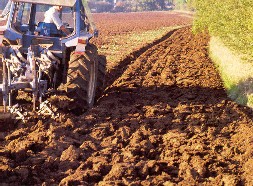Soils of the World
Did you know that there are thousands of different types of soil across the world? The USA alone possesses more than 20,000 varieties of soil!
In this section you will find out about the main reasons why soils differ regionally, as well as soil mapping, and the numerous attempts which have been made to classify them.
Why do Soils Differ?
There are numerous reasons why soils differ regionally. The most influential factors include the parent material (the rocks from which the soil has come), the climate and terrain of the region, as well as the type of plant life and vegetation present, and, of course, human influence.
Parent material - this refers to the original underlying rock upon which the soil formation takes place. Essentially, the nature of parent rock in a particular region will affect the type of soil that eventually develops. For example, in an area of mainly sandstone, the soil formed due to the weathering of the rock is likely to be well-drained, course and sandy.
Climate – The world consists of a broad range of climatic regions, each with its own specific types of soil. A common example of this is tundra soil, which tends to occur mainly in northern-hemisphere areas such as the Arctic and Scandinavia, where the climate is often cold and hence the organic materials do not break down very easily and peat tends to form. In contrast, red and grey ‘desert’ soils which are found only in hot, arid regions, such as Africa and the Middle-East, contain very small amounts of organic material because it is rapidly oxidised under the warm conditions. These soils but are less leached than the tundra soils.
Terrain – this is another important factor in soil development. Areas with many slopes in the land tend to have more freely drained soils, as water can run off or percolate more rapidly. In contrast, regions with mostly flat areas of land can often be waterlogged, because of the lack of gradient to promote lateral or sideways flow.
Plants – The type of plant life and vegetation obviously varies according to a region’s climate and other factors. Plants also have a strong influence on soil development – they take up nutrients from the ground, whilst adding organic material to the soil surface.
Humans – We should not forget the influence of man who has managed the land over the last few thousand years. Agriculture, in particular, has had a big influence on developing the soils we see today.
| ||
  | ||
Soil Classification
Over the years, there have been numerous attempts to give names to soils and to group them into natural classes, in much the same way as plants are named and classified. Classification is important in order to allow comparison between the soils of different regions, and to facilitate information transfer and organisation of the growing knowledge about the main types of soil that occur around the world.
The first true soil classification was produced in the second half of the 19th century by Dokuchaiev in the USSR. Dokuchaiev suggested a theory of ‘zonal soils’, where soil types came from clearly defined geographical and climatic locations.
In 1953, Kubiena produced a system of classification that proved to be popular and is still widely referred to. His system consisted of 5 main soil groups (and many sub-groups), arranged according to specific horizon classes, as well the type of 'humus' present.
Influenced by Kubiena’s ideas and other previous classifications, two international soil classifications have been developed since the 1960s, the American ‘7th Approximation’ classification system published in 1960, and the Food and Agriculture Organisation classification in the 1970s.
These have been many attempts to provide a unifying classification as a basis for technology transfer, but this has been hindered by the use of new, often complex terminology for describing soils. For example, the American class names in their system include the terms 'entisols', 'inceptisols', 'aridisols', 'mollisols', 'spodosols', 'alfisols', 'ultisols', 'oxisols' and 'histosols', which to the layman may not mean very much! Although the American and FAO systems are widely discussed and referred to, many countries still use their own national classification systems by preference.
It is incredible to think that there is still so much that is unknown about soil types, and that new discoveries are continuously being made all the time. Unfortunately, there is still currently no universal standard for soil classification, although the recent World Reference Base (WRB) for soils may address this in the future.

No comments:
Post a Comment